Home Tags Posts tagged with "India"
India
The controversial Indian Food Security Bill that aims to provide subsidized food to two-thirds of the population has been passed by the lower house.
Under the plan, which still needs to be approved by the upper house, 800 million poor people would receive 11 lbs of cheap grain every month.
Its backers argue it is a big step towards eradicating the widespread hunger and malnutrition plaguing India.
But critics say it is a profligate plan which will hurt India’s economy.
The ambitious legislation will cost 1.3 trillion rupees ($23.9 billion) a year.
The government launched the programme last week by executive decree, but requires parliamentary approval to make it permanent.
In a rare speech to parliament on Monday, Congress party President Sonia Gandhi urged lawmakers to clear her party’s flagship welfare scheme, which she said was part of an “empowerment revolution” worthy of unanimous support.

India’s Food Security Bill aims to provide subsidized food to two-thirds of the population
“Some people ask – do we have the resources for such a legislation? I would like to say, the question is not about resources; we will have to manage resources for this,” Sonia Gandhi said.
“The question is not if we can do this. We have to do this,” she told lawmakers in the lower house.
India accounts for a third of the world’s poor and supporters say such assistance will help reduce poverty and hunger.
But critics have dismissed the bill as a political gimmick ahead of next year’s general election.
“It’s not food security, but a vote securing bill,” opposition BJP MP Murli Manohar Joshi said in parliament before Sonia Gandhi spoke.
The bill proposes to provide a kilo of rice at three rupees, wheat at two rupees and millet at one rupee.
The measure will apply to 75% of Indians living in rural areas and 50% of the urban population.
The bill was an election promise made by the governing Congress party and its implementation is expected to help the party in general elections due next year.
But it has had a rocky journey through the legislative process. Last month, the cabinet passed the measure as an ordinance using special constitutional powers to enable President Pranab Mukherjee temporarily to sign it into law.
But parliamentary approval is needed before 6 September – when the current session of parliament ends – for it to remain lawful.
Opposition parties criticized the government for passing the measure as an ordinance, after initially failing to win parliamentary support.
Despite impressive economic growth in recent years, India still struggles to feed its population and has more malnourished children than any other country in the world.
[youtube u7EPSeN_8EM]
An Indian submarine caught fire after an explosion in a Mumbai dockyard killing the navy personnel, India’s defense minister has said.

The submarine caught fire after an explosion in a Mumbai dockyard
AK Antony said he felt “sad about those navy personnel who lost their lives”. Earlier reports said at least 18 sailors were feared trapped.
The blast on the INS Sindhurakshak took place after midnight and firefighters spent four hours putting out the fire.
Officials said the diesel-powered vessel was badly damaged.
It remains partly submerged at its berth.
[youtube 1_ffdv_sQoE]
India has launched INS Vikrant, its first indigenous aircraft carrier, from a shipyard in southern Kerala state.
The 37,500 tonne INS Vikrant is expected to go for extensive trials in 2016 before being inducted into the navy by 2018, reports say.
With this, India joins a select group of countries capable of building such a vessel.
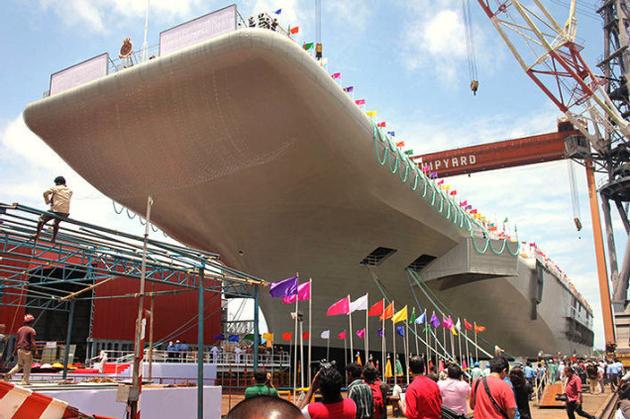
India has launched its first indigenous aircraft carrier from a shipyard
Other countries capable of building a similar ship are the US, the UK, Russia and France.
Monday’s launch of INS Vikrant marks the end of the first phase of its construction.
The ship will be then re-docked for outfitting and further construction.
The ship, which will have a length of 850 ft and a breadth of 196 ft, has been built at the shipyard in Cochin.
It was designed and manufactured locally, using high grade steel made by a state-owned steel company.
Vice-Admiral RK Dhowan of India’s navy has described the launch as the “crowning glory” of the navy’s programme to produce vessels on home soil.
[youtube Mm5d4mFegqw]
The daughters of former Indian Maharaja Harinder Singh Brar have won a 21-year court battle to inherit more than $4 billion worth of assets.
A court in the northern city of Chandigarh said the will of Harinder Singh Brar, Maharaja of Faridkot – who died in 1989 – had been forged.
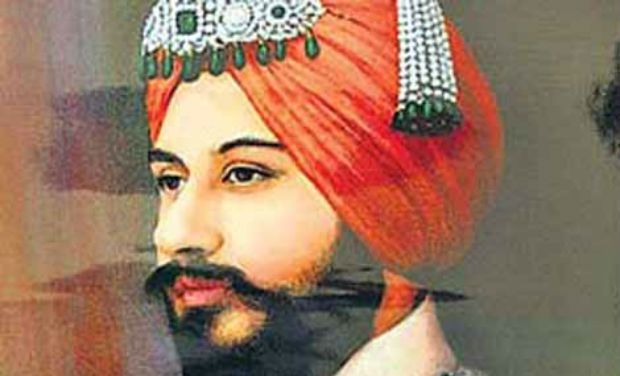
A court in the northern city of Chandigarh said the will of Harinder Singh Brar, Maharaja of Faridkot, who died in 1989, had been forged
The will had left Maharaja Harinder Singh Brar’s wealth in the care of a charitable trust set up by some of his servants and palace officials.
The assets include a 350-year-old royal fort and a private aerodrome.
But his daughter Amrit Kaur claimed the will had been written under duress, at a time when the maharaja was suffering from depression.
The court ruled in her favor, declaring the document void. The will came to light following the death of Harinder Singh Brar.
Harinder Singh Brar’s two surviving daughters will now inherit all the assets, which also include a property on one of Delhi’s most expensive streets as well as gold and vintage cars.
Harinder Singh Brar was the titular ruler of the Faridkot area of Punjab before India became independent in 1947.
At least 22 children have died and dozens more have fallen sick in India’s eastern state of Bihar after eating a tainted school meal.
The poisoning occurred at a government school in the village of Masrakh in Saran district.
India’s Mid-Day Meal Scheme provides free food to try to boost attendance, but often suffers from poor hygiene.
Angry parents joined protests against the deaths, setting at least four police vehicles on fire.
An inquiry has begun and 200,000 rupees ($3,370) in compensation offered to the families of each of the dead.
Twenty-eight sick children were taken to hospitals in the nearby town of Chhapra and the state capital, Patna, after the incident.
A total of 47 students of a primary school in Dharmasati Gandaman village fell sick on Tuesday after eating the free lunch.
There are fears the number of dead could rise as some of the children, all below the age of 12, are critically ill.
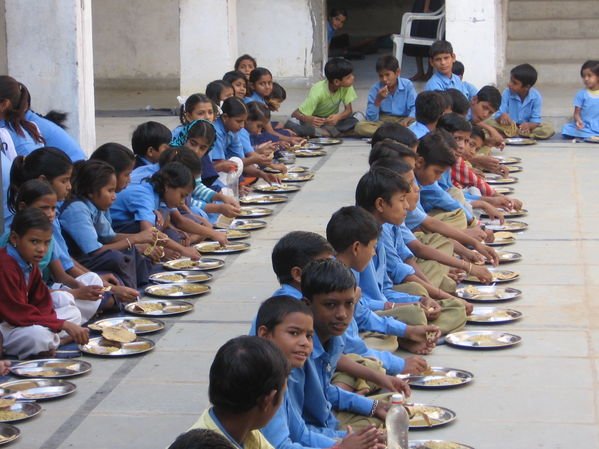
Mid-Day Meal is the world’s largest school feeding programme, reaching 120 million children in 1.2 million schools across India
The father of one sick child, Raja Yadav, said his son had been vomiting after returning from school and had to be rushed to hospital.
The state education minister, PK Shahi, said a preliminary investigation indicated that the food was contaminated with traces of phosphorous.
“The doctors who have attended are of the tentative opinion that the smell coming out of the bodies of the children suggests that the food contained organo-phosphorus, which is a poisonous substance,” he said.
“Now the investigators have to find out whether organo-phosphorus was accidental or there was some deliberate mischief.”
Earlier, doctors treating the patients had said “food poisoning” was the cause of the deaths.
“We suspect it to be poisoning caused by insecticides in vegetable or rice,” said Amarjeet Sinha, a senior education official.
A doctor treating the children at a hospital in Patna said contaminated vegetable oil could have led to the poisoning.
Patna-based journalist Amarnath Tewary says villagers told local reporters that similar cases of food poisoning after having Mid-Day Meals had taken place in the area previously.
Bihar Chief Minister Nitish Kumar called an emergency meeting and ordered a team of forensic experts to the school.
Bihar is one of India’s poorest and most populous states.
The Mid-Day Meal is the world’s largest school feeding programme, reaching 120 million children in 1.2 million schools across the country, according to the government.
PK Shahi acknowledged “that food is not being checked before it is being served”.
He added that “the scale at which the operation is being carried out, serving food to 20 million children every day and that too in remotest village schools, checking food before it is served – that itself is a challenge”.
The Mid-Day Meal was first introduced for poor and disadvantaged children in the southern city of Chennai in 1925.
[youtube tQeYt3OQuF4]
At least 12 people have been killed in the City Light hotel collapse in the southern Indian city of Secunderabad, police says.
At least 18 more people were injured when the two-storey hotel came crashing down on Monday morning.
Police said it was not clear how many people were trapped under the debris at the hotel, located near Hyderabad.
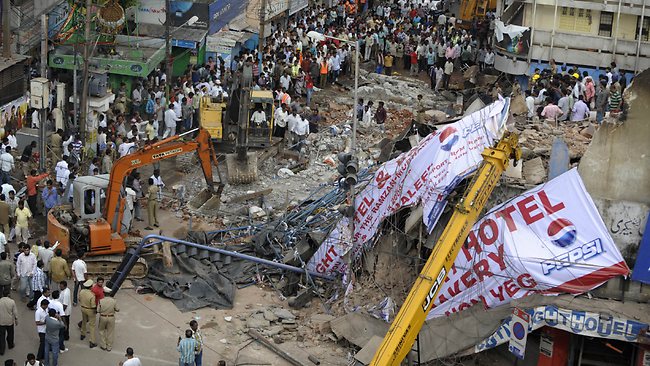
At least 12 people have been killed in the City Light hotel collapse in the southern Indian city of Secunderabad
Correspondents say such incidents are common in India and are often blamed on poor construction practices.
About 25 people were working at the hotel, located on a busy road in Secunderabad, when one of its kitchen walls collapsed, burying some of the employees, senior police official B Surender told the AFP news agency.
“The building was very old and the walls showed cracks, according to people working nearby,” he added.
Last month, nine people were killed in two separate building collapses in the western city of Mumbai.
In April, 74 people were killed in another building collapse on the outskirts of Mumbai.
[youtube HUKlbFtS8So]
According to the United Nations, India looks set to overtake China as the world’s most populous country from 2028.
At that point, India and China will number 1.45 billion people each. Subsequently India’s population will continue to grow until the middle of the century, while China’s slowly declines.
The UN also estimates that the current global population of 7.2 billion will reach 9.6 billion by 2050.
That is a faster rate of growth than previously estimated.
The population growth will be mainly in developing countries, particularly in Africa, the UN says.
The world’s 49 least developed countries are projected to double in size from around 900 million people in 2013 to 1.8 billion in 2050, whereas the population of developed regions will remain largely unchanged.
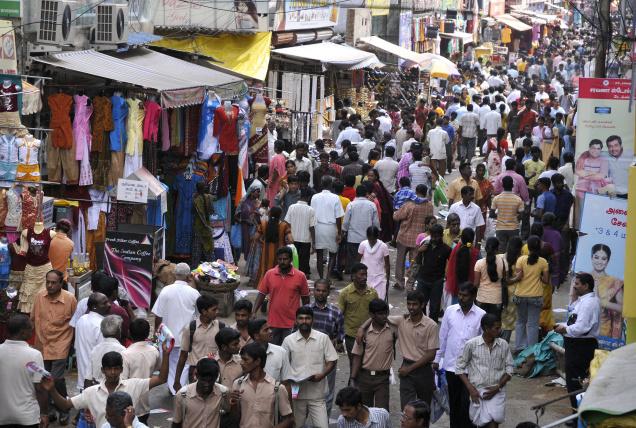
India looks set to overtake China as the world’s most populous country from 2028
The UN said the reason for the increase in its projection for total global population in 2050 is largely new information on fertility levels in certain high birth rate countries.
Large developing countries, such as China, India and Brazil, have seen a rapid fall in the average number of children per woman, but in other nations, such as Nigeria, Niger, Ethiopia and Uganda, fertility levels remain high.
Nigeria’s population is expected to exceed that of the United States by the middle of the century, and could start to rival China’s by 2100.
China’s population is expected to start decreasing after 2030.
“Although population growth has slowed for the world as a whole, this report reminds us that some developing countries, especially in Africa, are still growing rapidly,” commented Wu Hongbo, the UN’s Under-Secretary-General for Economic and Social Affairs.
The UN publishes an assessment of past, current and future population trends every two years, in a recurrent series known as the World Population Prospects.
Researchers have used data for 233 countries and areas to produce Friday’s report.
[youtube qJ8RJ6A8dp4]
A building collapse has killed at least 34 people in Thane, near Indian city of Mumbai, officials say.
Dozens are injured and many others are feared trapped beneath the seven-storey building under construction in Thane, Indian media report, quoting officials.
Indian police said the building was being constructed illegally and four floors were already occupied.
Building collapses are common in India. Poor construction material and practices are often blamed.
A growing population and a lack of space has seen an increase in the number of high rises, but many builders fail to take sufficient safety precautions, or obtain proper permission to build.

A building collapse has killed at least 34 people in Thane, near Indian city of Mumbai
A section of the building collapsed on Thursday evening, bringing the entire structure down, a police official in Thane, Maharashtra state, said.
He said at least nine children were among the dead.
Rescue efforts continued through the night.
The disaster management officials in Thane district said 57 people were injured.
Most of the victims were construction workers who were staying in the building, he added.
In December 2013 at least 13 people died when part of a half-constructed building collapsed in the Wagholi area of Maharashtra.
Last September at least six people were killed when a building collapsed in Pune city in Maharashtra.
[youtube cFSBDrnZUbk]
India’s Supreme Court has rejected a plea by Swiss drugmaker Novartis to patent an updated version of its cancer drug, Glivec.
Novartis had been denied a patent by Indian authorities on the grounds that Glivec new version was only slightly different from the old.
There were concerns that a patent could threaten access to cheap generic versions of drugs in poorer countries.

India’s Supreme Court has rejected a plea by Swiss drugmaker Novartis to patent an updated version of its cancer drug, Glivec
But some Western companies had warned that a decision against Novartis could discourage investment in research.
Glivec, which is used to treat chronic myeloid leukaemia and other cancers, costs about $2,600 a month.
The generic equivalent is currently available in India for just $175.
“This will go a long way in providing affordable medicine for the poor,” said Anand Grover, a lawyer representing Cancer Patients Aid Association, adding that he was “ecstatic with the ruling”.
Novartis applied for a patent in 2006 for its new version of the drug, arguing that it was easier to absorb and therefore qualified for a fresh patent.
However, the Indian patent authority rejected the application based on a law aimed at preventing companies from getting fresh patents by making only minor changes to existing drugs, a practice known as “evergreening”.
Officials also turned down a subsequent appeal by the company three years later.
On Monday, India’s Supreme Court rejected Novartis appeal to get patent protection for the drug.
The AFP news agency quoted the court as saying that the updated drug “did not satisfy the test of novelty or inventiveness” as required by the law.
Patents usually protect the companies for 20 years of exclusive sales. After that, it is open to other firms who can make cheaper copies of the original drug.
Once the protection expires, the first company to challenge the patent gets an exclusive right to sell the copy for 180 days.
After 180 days, more companies can sell the generic versions, potentially resulting in a further price drop.
It is estimated that drugs with combined annual sales of $150 billion will go off-patent by 2015.
India’s generic drug makers are among the biggest in the world and many expect them to benefit from these patents expiring in the coming years.
However, there have been concerns that if firms are granted patents for updated versions of their drugs, it may not only deny access to cheaper medicines to poor people, but also hurt the makers of generic drugs.
Pratibha Singh, a lawyer for the Indian generic drug manufacturer Cipla, said the ruling had set a precedent that would prevent international pharmaceutical companies from obtaining fresh patents in India on updated versions of existing drugs.
“Patents will be given only for genuine inventions, and repetitive patents will not be given for minor tweaks to an existing drug,” she said.
Shares of Novartis India fell almost 5% on the Bombay Stock Exchange, while stocks of generic drugmakers such as Cipla and Natco rose after the judgement.
[youtube Q3caoYConU4]
An Indian commission set up to suggest reforms to country’s rape laws after last month’s Delhi gang rape of a student has called for faster trials.
The panel, led by former chief justice JS Verma, also called for longer sentences but not the death penalty.
India’s law minister said the report would get “government attention” soon.
The brutal assault on the 23-year-old student in Delhi in December shocked India and sparked a debate about the treatment of women.
Justice JS Verma said his three-member commission had received 80,000 responses from India and abroad on how to reform rape laws.
Among the recommendations of the report, submitted to the home ministry on Wednesday, were:
- broadening of the definition of what constituted sexual assault
- cases to be tried in specially designated courts, preferably by women judges
- quicker trials and faster processing of appeals in cases of crimes against women
- more accountability for the police
- better implementation of laws and the need for a change in the mindset of law-enforcers
- strong action against those found guilty of trafficking and against security forces convicted of sexual assault in conflict zones.
- uniform national protocol for the treatment and medical examination of rape survivors
The panel also recommended that those found guilty of rape leading to death spend the rest of their life in prison, but it stopped short of calling for the death penalty, something which many in India had pushed for.
“What is needed to enforce laws is the sensitivity on the part of those who implement it,” he told a news conference after submitting the report to the home ministry in Delhi.
“The state’s role is not just punishing criminals but also to prevent crimes against women,” he said.
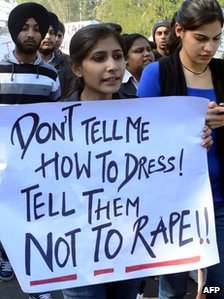
An Indian commission set up to suggest reforms to country’s rape laws after last month’s Delhi gang rape of a student has called for faster trials
Justice JS Verma said the authorities had failed in their duties to the public.
He said that despite the huge number of responses to the commission’s request for ideas, not a single Indian state police chief had sent recommendations.
The head of the panel also praised young people for going into the streets to protest about the status quo.
“Youth has taught us what we, the older generation, were not aware of. I was struck by the peaceful manner in which the protests were carried out… the youth rose to the occasion,” he said.
Justice Leila Seth, another member of the commission, said police “don’t take complaints of rape victims seriously”.
“There is institutional bias against the weaker sections of society,” she said.
The Verma committee also looked at marital rapes and physical, sexual and psychological violence in the family.
Justice JS Verma said he hoped that the report would be taken seriously by the government.
The student raped in December, who cannot be named for legal reasons, was attacked after boarding a bus in south Delhi with a male friend.
Police said the assailants beat both of them, and then raped the woman. She suffered massive internal injuries and died nearly two weeks later.
The incident led to nationwide protests against the treatment of women in India. Campaigners called for tougher rape laws and reforms to the police, who have been accused of often failing to file charges against attackers.
Earlier this week, the trial of five men held for the crime began at a specially convened fast-track court.
If convicted, the men could face the death penalty. A sixth suspect, who is thought to be 17, is expected to be tried by a juvenile court.
The government has said it will bring in stronger sexual assault laws and has established several committees to recommend changes.
It has also promised to fast-track future rape cases. Legal proceedings in India sometimes involve years of delays.
There are believed to be about 95,000 rape cases pending nationwide, according to Ranjana Kumari, a women’s activist.
Five elephants have been killed after being hit by a passenger train in the eastern Indian state of Orissa.
The animals were hit when their herd was crossing railway tracks in the Rambha forest area, a railway spokesman, RN Mohapatra, said.
The state’s wildlife department said its warning asking trains to slow down because elephants were moving in the area was ignored.
Nearly 300 elephants have been killed in Orissa in the past five years.

Five elephants have been killed after being hit by a passenger train in the eastern Indian state of Orissa
Most of the deaths have been blamed on accidental electrocutions, poaching, poisoning by farmers to prevent them from damaging crops and being run over by trains.
The state government recently set up a committee to monitor elephant deaths.
While elephants are worshipped by many in India, shrinking habitat has led to increased conflict with people and the deaths of many of the protected animals.
There are around 26,000 wild elephants in India, where it is a heritage animal.
[youtube d-TcO0GARF8]
Volunteers armed with drums and whistles are being used under a new scheme to shame people going to the toilet in public in the western Indian state of Rajasthan, officials say.
The scheme was launched on Monday in 34 villages in Jhunjhunu district.
Four to five people will “shout, beat drums or blow a whistle” if they see anyone urinating or defecating in the open, said an official.
Repeat offenders may even be asked to pay a fine, he said.
Nearly half of India’s 1.2 billion people have no toilet at home and they defecate in the open.
Correspondents say spitting, urinating and defecating in public are a common sight across India, and in rural areas many people continue to go out in the open even when they have toilets at home because they prefer the outdoors.
But the authorities in Jhunjhunu now want to change that behavior.
“Nearly 80% [of] villagers in the district have toilets at home and we’re trying to motivate the remaining 20% to build toilets at home,” said Ramniwas Jat, head of Jhunjhunu district council.
“We are also giving financial assistance of 9,100 rupees [$166] to people who wish to construct a toilet. We want people to not defecate in the open,” he said.

Spitting, urinating and defecating in public are a common sight across India
Officials say cultural and traditional factors, a lack of education and too few toilets are the prime reasons why millions of Indians defecate in the open.
Those with no access to toilets have to go to farms and fields and women have to go before dawn or after dark in order to preserve their modesty.
Last year, in Madhya Pradesh a newly-wed woman left her husband’s home two days after her marriage because the house had no toilet.
Defecating in the open is also blamed for the spread of a number of diseases such as tapeworm.
Diseases spread by human waste
- Ascariasis: An intestinal infection from a large roundworm (growing up to 30 cm) whose eggs are found in contaminated soil. Kills 60,000 a year
- Cholera: A global public health threat with up to five million cases a year, it results in profuse diarrhoea/vomiting and can kill within hours
- Dysentery: Highly contagious bacterial infection. Outbreaks are likely in areas where poor hygiene practices exist
- Typhoid fever: An infection of the intestine and bloodstream causing fever, headache and diarrhoea. 17 million cases a year
- Trachoma: Infection which turns the eyelid inwards, causing eyelashes to rub and scar the eyeball. An estimated six million worldwide are blind due to the disease
Source: WaterAid/WHO
Indian opposition parties and trade unions are staging a day-long strike over plans to open the country’s retail sector to global supermarket chains.
Calcutta and Bangalore were virtually shut down, but the response in other parts of the country was mixed.
The reforms, which ministers say are needed to revive the economy, were formally introduced on Thursday.
But small shops fear they will be put out of business and many people are angry at recent fuel price rises.
Earlier in the week a key ally left the ruling coalition in protest, although its majority in parliament is not at immediate risk.
The Congress-led government attempted to introduce the retail reforms last year, but backed down in the face of opposition.

Indian opposition parties and trade unions are staging a day-long strike over plans to open the country's retail sector to global supermarket chains
Thursday’s nationwide strike, called by the main opposition Bharatiya Janata Party (BJP), its allies and Communist parties, has shut down schools, businesses and public transport in many cities.
TV channels showed protests taking place in the cities of Patna, Allahabad and Varanasi in northern India.
Most businesses were shut in the eastern city of Calcutta and public transport was disrupted, reports said, with workers also blocking railways in Uttar Pradesh and Bihar states.
The southern state of Karnataka, which is governed by the BJP, was shut down in response to the strike call, with buses off the roads and schools, hotels and businesses closed. The state capital, Bangalore – home to hundreds of IT companies including multinationals like IBM and Microsoft – was completely shut down.
“We have asked our employees to stay back at home. We will instead work on Saturday,” an official of Infosys, one of India’s leading software companies, said.
“The fear factor is the reason for the closure,” a spokesperson for another multinational company said.
Much of the capital was operating normally on Thursday. There was a similar picture in the financial capital, Mumbai.
This may well signal that politically-led mass protests over a single issue no longer have the ability to shut down the entire nation.
It could also reflect the fact that the merits and demerits of such retail reforms are distant from ordinary members of the public.
The government’s plan is aimed at reviving a flagging economy, as well as avoiding the threat of a downgrade in India’s credit rating.
But many small shops fear for the future. Delhi-based trader, Deepak Sethi, said shopkeepers would lose business if foreign supermarkets were allowed into India.
“Multinational companies will destroy the economic and social fabric of the country and will adversely impact traders, transporters, farmers and other sections of retail trade,” Praveen Khandelwal, the head of the group, was quoted as saying by AFP news agency.
“These big companies can attract customers by selling at cost prices. That means people here are going to lose jobs. Shops like ours will be hit the most.”
The Trinamool Congress party, a key ally of the ruling coalition, has said it will pull out of the government and withdraw support in parliament. Its six ministers are to resign on Friday.
The government also announced a 14% rise in the price of diesel, which is heavily subsidized in India. That move has also prompted great anger across the country.
Under the government’s proposal, global firms – such as Walmart and Tesco – will be able to buy up to a 51% stake in multi-brand retailers in India.
Multinational retailers already have outlets in India, but at present they can sell only to smaller retailers. This decision allows them to sell directly to Indian consumers.
Indian Prime Minister Manmohan Singh has said the reforms would “help strengthen our growth process and generate employment in these difficult times”.
Indian police have stopped prominent anti-corruption campaigner Baba Ramdev from marching to parliament to stage a protest in Delhi.
Baba Ramdev and his supporters have been detained for allegedly “violating prohibitory laws”.
Known as the yoga guru, Baba Ramdev says he is campaigning for the recovery of bribe money allegedly held overseas.
He is also demanding stronger anti-corruption laws. He has millions of supporters across India.
Baba Ramdev’s daily TV programme is watched by people across the country.

Indian police have stopped prominent anti-corruption campaigner Baba Ramdev from marching to parliament to stage a protest in Delhi
Last June he held a nine-day anti-corruption hunger strike before the police evicted him from Delhi.
His latest protest – attended by several thousand people – was held at the Ramlila ground in Delhi, the venue of his protest last year.
Baba Ramdev told his supporters on Monday that they should march to parliament and hold a “peaceful” protest there.
“Throw out the Congress [the governing party] and save the country,” he said, before beginning his march.
But police stopped him and his supporters near a flyover in the city and detained them.
On Sunday, Baba Ramdev said he would “intensify the protest across the country in the form of a people’s revolt”.
He asked his supporters to be ready to court arrest, but urged them to be peaceful.
In June, the yoga guru joined leading campaigner Anna Hazare to undertake a day-long fast in protest against corruption.
India has successfully launched Agni-V, a long-range intercontinental ballistic missile able to carry a nuclear warhead, officials say.
The locally-developed Agni-V missile was originally scheduled to launch on Wednesday in the eastern state of Orissa.
Officials had delayed the launch because of heavy lightning in the area.
The missile has a range of more than 5,000km (3,100 miles), within range of targets in China.
Analysts say the Agni (meaning “fire” in Hindi and Sanskrit) missile family is to be the cornerstone of India’s missile-based nuclear deterrent.
The missiles are among the country’s most sophisticated weapons.

India has successfully launched Agni-V, a long-range intercontinental ballistic missile able to carry a nuclear warhead
In 2010, India successfully test-fired Agni-II, an intermediate-range ballistic missile with a range of more than 2,000km (1,250 miles).
The Agni-V missile was launched from Orissa’s Wheeler Island at 08:05 local time on Thursday.
“It was a perfect launch. It met all the test parameters and hit its pre-determined target,” said SP Das, director of the test range.
Indian Prime Minister Manmohan Singh congratulated the scientists for the “successful launch” of the missile.
“Today’s launch represents another milestone in our quest for our security, preparedness and to explore the frontiers of science,” he said.
The missile took about 20 minutes to hit its target somewhere near Indonesia in the Indian Ocean.
Defense analyst Rahul Bedi says a successful test flight of the Agni-V missile, which is capable of delivering a single 1.5-ton warhead deep inside nuclear rival China’s territory, would strengthen India’s nuclear deterrence once it comes into service by 2014-15.
It is 17.5 m tall, solid-fuelled, has three stages and a launch weight of 50 tons. It has cost more than 2.5 billion rupees ($480 million) to develop.
Only China, Russia, France, the US and UK have such long-range missiles. Israel is thought to possess them.
“Agni-V is to meet our present-day threat perceptions, which are determined by our defense forces and other agencies,” DRDO Ravi Gupta spokesman told AFP news agency ahead of the launch.
“This is a deterrent to avoid wars and it is not country-specific,” he said.
[youtube Io-9edOgs0o]
Almost half of India’s 1.2 billion people have no toilet at home, but more people own a mobile phone, according to the latest census data.
Only 46.9% of the 246.6 million households have lavatories while 49.8% defecate in the open. The remaining 3.2% use public toilets.
Census 2011 data on houses, household amenities and assets reveal that 63.2% of homes have a telephone.
Analysts say the data show the complex contradictions of the Indian system.
They say the census reveals a country where millions have access to cutting-edge technology and consumer goods but a larger number of poor who lack access to even basic facilities.
About 77% of homes in the eastern state of Jharkhand have no toilet facilities, while the figure is 76.6% for Orissa and 75.8% in Bihar. All three are among India’s poorest states with huge populations which live on less than a dollar.
“Open defecation continues to be a big concern for the country as almost half of the population do it,” Registrar General and Census Commissioner C. Chandramouli said while releasing the latest data.
“Cultural and traditional reasons and a lack of education are the prime reasons for this unhygienic practice. We have to do a lot in these fronts,” he said.
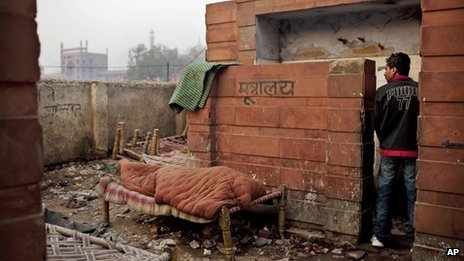
Almost half of India's 1.2 billion people have no toilet at home, but more people own a mobile phone, according to the latest census data
The data also reveal that Indians now largely live in nuclear families with 70% of homes consisting of only one couple – a dramatic change in a country where joint families were always the norm.
The census figures also show changes in how people access information and entertainment.
More than half of population – 53.2% – has a mobile phone.
There has been a 16% rise in the number of homes with television sets, while the use of radios has declined by 15%.
The data show that 47.2% of households have a television while only 19.9% have a radio.
And the reach of computers with internet access is still miniscule, with only 3.1% of the population connected.
Passengers aboard a Finnair flight from Helsinki to New Delhi were pleasantly surprised when the aircraft’ staff treated them with a Bollywood-style dance to celebrate India’s 63rd Republic Day.
A video showing the smiling Finnair staff treating passengers to the choreographed routine, has become a hit on YouTube, receiving more than half-a-million hits in just one day.
Helena Kaartinen, the flight attendant who came up with the idea, coordinated rehearsals and even enlisted the help of a former flight attendant friend in Mumbai, who is now a Bollywood teacher.
She uploaded videos of the team practizing and expert Manish Gawde corrected the choreography ahead of the performance.

Passengers aboard a Finnair flight from Helsinki to New Delhi were pleasantly surprised when the aircraft' staff treated them with a Bollywood-style dance to celebrate India's 63rd Republic Day
Helena Kaartinen told the New York Times: “It was a good way to show respect.”
The flight attendant said she was keen to show Indian passengers that the airline did know something about their culture.
The performance took place on a flight on January 17 and was uploaded to Finnair’s YouTube channel on January 25 to mark India’s Republic Day on January 26.
So far, the video clip has received more than 1.7 million viewings.
[youtube mEsnb3kUDAw]
Indian police say at least 48 people have died after consuming toxic alcohol in country’s West Bengal state.
Several residents of the Magrahat, Usthi and Mandirbazar areas in South 24 Parganas district fell ill after drinking the alcohol on Tuesday night.
Four people have been arrested.
Some 100 others are being treated in hospital in the Diamond Harbour area, with fears the death toll could rise.
Toxic alcohol deaths are a regular occurrence in India.
Last week, the state of Gujarat brought in a new law making the illegal manufacture and sale of toxic alcohol there punishable by death.
About 70 people are in a critical condition, said state government minister Shyamal Mandal.
“More and more people are turning up with symptoms of liquor poisoning and one local hospital is now overcrowded,” district administrator NS Nigam told the AFP news agency.
Some of the critically ill had been transferred to Calcutta, Shyamal Mandal said.
Medicine and doctors were being rushed to the Diamond Harbour hospital.
Four breweries were ransacked after the deaths began to be reported, AFP quoted officials as saying.
Illegal alcohol – commonly called desi daroo or country-made liquor in India – usually costs as little as 10 rupees (20 US cents) and the majority of the consumers are poor, daily-wage workers.
The liquor is usually spiked with methyl alcohol and industrial spirits which can lead to fits, vomiting and death.
India has witnessed many incidents of toxic alcohol deaths.
• At least 10 people killed in Tamil Nadu in February 2010
• At least 30 people killed in Uttar Pradesh in September 2009
• Some 107 people killed in Gujarat in July 2009
Gujarat has taken the strongest action on toxic liquor with its new law, which it says is intended to deter those involved in the illegal trade.
Gujarat is the only state in India where alcohol is totally prohibited by law.
Indian officials say at least 73 people have been killed in a fire that broke out in a hospital in the city of Calcutta (Kolkata).
Many of the dead people were patients who were trapped after the flames spread through the AMRI hospital in the southern part of Calcutta.
The fire started early on Friday in the multi-storey hospital’s basement, where flammable materials were stored.
Fire engines fought the blaze for five hours before bringing it under control.
West Bengal Chief Minister Mamata Banerjee said the license of the hospital had been cancelled.
Mamata Banerjee said fire was an “unforgivable crime” and that those responsible would be given the harshest punishment.
Officials say the death toll is likely to rise as rescue workers are trying to reach the upper floors of the six-storey hospital in Dhakuria.
A Upadhay, a senior vice-president of the AMRI hospital company, told Associated Press there were 160 patients in the 190-bed hospital.
West Bengal Urban Development Minister Firhad Hakim said many of the patients who died had suffocated on fumes.
A number were rescued. “We have taken 50 patients to an adjacent hospital. The situation is grim at the moment,” fire brigade chief Gopal Bhattacharya told Agence France-Presse news agency.
Bodies of patients wrapped in white sheets have been brought out by rescue workers, BBC reported.
Local people climbed into the hospital compound to rescue patients before fire engines arrived, our correspondent says.
The narrow surrounding streets made it difficult for the rescue service to arrive quickly.
The fire spread swiftly from the basement to the upper floors of the private hospital.
Television pictures showed patients being carried out on stretchers, with distraught relatives of trapped patients crowded outside the building.
One rescued patient said: “The attendants woke me up and dragged me down the stairs. I saw 10-15 patients at the top of the stairs trying to get down.”
Ananya Das, 35, who underwent surgery at the hospital on Thursday, said she was recovering when the fire broke out.
“I managed to walk towards an exit and then climb out of a window. I saw a lot of bodies,” she said.
More than 40 people died in a huge fire in a historic building in Calcutta in March last year.
Fires in high-rise buildings are fairly common in the city. There have been at least 10 major incidents since 2008.
Electrical short circuits have been responsible for most of these fires.
[youtube zlc4zZ66x2M]
Enmac is an Islamic smartphone that has been launched with a compass pointing permanently to Mecca and the Koran already downloaded.
Indian inventors of the Enmac said they focused on religious technology when designing the new phone.
And the market is heaving as India has the fastest growing mobile phone users in the world with more than 850 million subscribers including farmers and rickshaw drivers.

Enmac is an Islamic smartphone that has been launched with a compass pointing permanently to Mecca and the Koran already downloaded
Anuj Kanish, who has launched the Enmac in India, told The Telegraph: “India has around 180 million Muslims and the penetration of mobile phone in that community is less.
“But when a compelling product or service is available, it has a potential to increase the number of users. So far, we have had a tremendous response for the product.
“Religion has a very important place in Indian society, so has the mobile phone. Our aim was to bring a device which caters to both the sections, the product is a combination of both technology and religion, the first of its kind in India.”
Enmac translates the Koran from Arabic into 29 languages, and includes the Hadith sayings of the Prophet Mohammed, and a guide for Indian Muslims on how to perform the Hajj rituals in Mecca and Medina.
Anuj Kanish said his company had focused on “religious technology” to help customers with busy lives “remain connected with God”.
More than seven hundreds people are gathering in Mumbai University campus for India’s first Wikipedia conference.
Wikipedia Conference 2011 is a three-day event, from November 18 to Nvember 20, and is part of the online encyclopedia’s plans to expand in the sub-continent.
Wikipedia wants to tap into India’s growing internet population, by creating more pages in local languages, such as Hindi, Marathi and Gujerati.
The online encyclopedia representatives say the conference is the one of the largest gatherings it has ever held.
The campus of Mumbai University has, for the weekend, been overtaken by more than 700 “Wikimedians”.
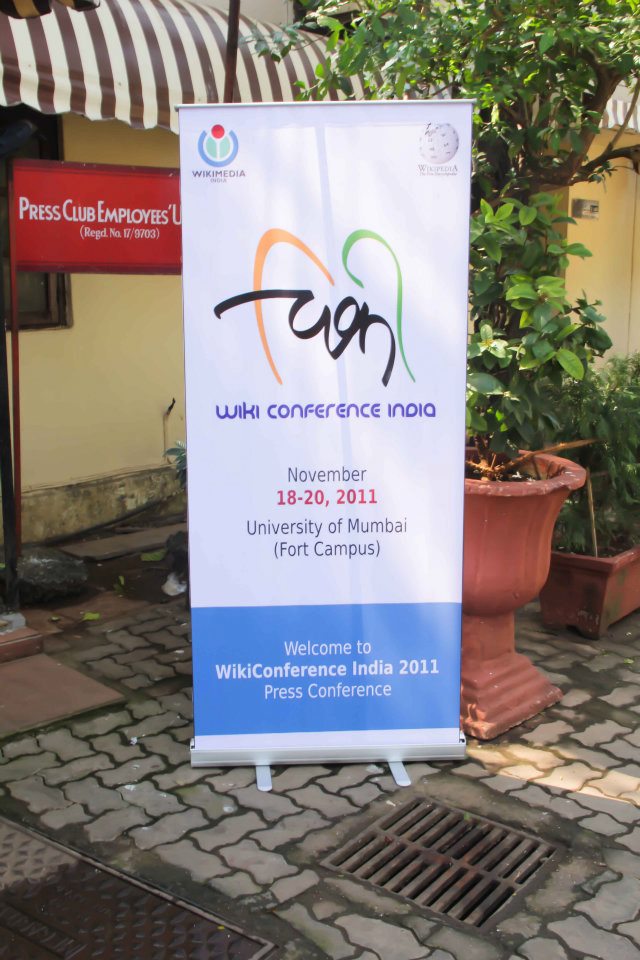
More than seven hundreds people are gathering in Mumbai University campus for India's first Wikipedia conference
For those who have not read the relevant explanatory entry online, they are avid readers and editors of Wikipedia.
Abishek Suryawanshi, 21, from Pune is one such Wikimedian.
He believes more Indians should get online and write entries – because there is so much to share.
“India has a vast knowledge from Rig Veda and Bhagavad Gita [sacred texts], to the current nanotechnology and bio-technology, so I think that a platform like Wikipedia will be perfect for Indians to showcase their knowledge.”
Wikipedia started out ten years ago, but is targeting India to take advantage of the country’s growing number of internet users – currently around 100 million.
“It’s an extremely important place for Wikipedia,” says Hisham Mundol from the Wikimedia Foundation.
“For starters there are a billion people out here and hundreds of millions of users are more comfortable thinking, dreaming, talking and counting in their mother tongues, so we need to really build the Indic language Wikipedia projects.”
The site has its supporters but detractors too.
Outside the campus a small group of protesters demonstrated against the depiction of the map of India on Wikipedia, which they say is an inaccurate and illegal representation of the country’s borders.
Wikipedia’s founder, Jimmy Wales, who flew in for the event, seemed unconcerned by the protests.
“I want Wikipedia to be neutral on such topics. It’s not up to us to decide what’s the correct map of India, but it is up to us to explain to people that there is this controversy.”
[youtube qquzVg4iido]
 Prev123Page 3 of 3
Prev123Page 3 of 3



















